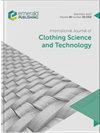An application of virtual twins for fit prediction: case study of women jackets
IF 1
4区 工程技术
Q3 MATERIALS SCIENCE, TEXTILES
International Journal of Clothing Science and Technology
Pub Date : 2023-03-07
DOI:10.1108/ijcst-08-2021-0106
引用次数: 0
Abstract
PurposeThe purpose of this paper is to present a fit prediction case study of virtual twins of women jacket. For this reason, several basic principles of clothes fit prediction were developed and verified.Design/methodology/approachTo develop the principles of fit prediction, the women's jacket sleeve was selected as the study object. The study objects were categorized into three types: the patterns and two virtual sleeves generating on full avatar from Clo3D and on dummy (arm partly removed). Through series of subjective and objective evaluation experiments, the relationship between the similar indexes of the patterns and the virtual sleeves was built, including fit criteria range, the categorization of the indexes in terms of its sensitiveness, and the linear regressions to predict several indexes of virtual sleeves after its pattern parameterization. The results obtained were verified in case study by the virtual and real sleeves generating.FindingsThe proposed principles of clothing fit prediction based on parallel research of the flat patterns and its virtual 3D shapes. The principles include the choosing of virtual twins of human body for virtual try-on, the establishing of indexes common schedule for patterns and virtual sleeves, the creation of criteria and its ranges for perfect fit and poor fit evaluation, and the application of existing relations between the patterns and the sleeves for predicting indexes responsible for fit.Research limitations/implicationsThe authors propose and verify the validity of the principles to predict several parameters of virtual 3D sleeve of women's jacket which are forming the level of fit. The result of this study can be used to convenient fit prediction and to find the misfit reasons.Practical implicationsThis study developed basic principles for predicting the fit of the clothing through the virtual simulation and the statistical analysis. Through studying the jacket sleeve, the several related ranges, the row of more sensitive indexes, and the equations were presented and verified, which certified the validity of proposed principles.Social implicationsThe results can effectively predict the sleeve fit before sewing, which reduce the time and materials cost and the operator's skill requirements.Originality/valueThe authors propose and verify the validity of the principles to predict several parameters of virtual 3D sleeve of women's jacket which form the level of fit. The result of this study can be used for convenient fit prediction and to find the misfit reasons.虚拟双胞胎在合身度预测中的应用——以女式夹克为例
目的介绍一个女夹克虚拟双胞胎的合身预测案例研究。为此,提出并验证了服装合身度预测的几个基本原理。设计/方法/方法为了制定合身预测的原则,选择女式夹克袖作为研究对象。研究对象分为三种类型:在Clo3D的完整化身和假人(手臂部分移除)上生成的图案和两个虚拟袖子。通过一系列主客观评价实验,建立了图案与虚拟袖的相似指标之间的关系,包括拟合标准范围、指标的敏感性分类,以及图案参数化后预测虚拟袖若干指标的线性回归。通过虚拟和真实套筒的生成,对所获得的结果进行了实例验证。发现基于平面图案及其虚拟三维形状的并行研究,提出了服装合身度预测的原理。其原理包括选择人体虚拟双胞胎进行虚拟试穿,建立图案和虚拟袖子的指标通用表,创建完美合身和不合身评价的标准及其范围,以及应用图案和袖子之间的现有关系来预测合身指标。研究局限性/含义作者提出并验证了预测女性夹克虚拟三维袖子几个参数的原理的有效性,这些参数正在形成合身程度。该研究结果可用于方便的拟合预测和查找失配原因。实践意义本研究通过虚拟仿真和统计分析,制定了预测服装合身度的基本原则。通过对套管的研究,提出并验证了几个相关范围、一排更敏感的指标和方程组,验证了所提原理的有效性。社会含义该结果可以有效地预测缝制前的袖子贴合度,从而降低了时间和材料成本以及操作者的技能要求。独创性/价值作者提出并验证了预测女性夹克虚拟三维袖子几个参数的原理的有效性,这些参数构成了合身程度。该研究结果可用于方便的拟合预测和找出不匹配的原因。
本文章由计算机程序翻译,如有差异,请以英文原文为准。
求助全文
约1分钟内获得全文
求助全文
来源期刊
CiteScore
2.40
自引率
8.30%
发文量
51
审稿时长
10 months
期刊介绍:
Addresses all aspects of the science and technology of clothing-objective measurement techniques, control of fibre and fabric, CAD systems, product testing, sewing, weaving and knitting, inspection systems, drape and finishing, etc. Academic and industrial research findings are published after a stringent review has taken place.

 求助内容:
求助内容: 应助结果提醒方式:
应助结果提醒方式:


